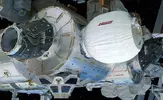Space balloons are the thing.....
The Bigelow Expandable Module Is About To Blow Up
http://www.universetoday.com/129122/bigelow-expandable-module-blow/

People who aren’t particularly enthusiastic about space science and space exploration often accuse those of us who are, of “living in a bubble.” There are so many seemingly intractable problems here on Earth, so they say, that it’s foolish to spend so much money and time on space exploration. But if all goes well with the Bigelow Expandable Activity Module (BEAM) at the ISS this week, astronauts may well end up living in a sort of bubble.
Expandable, inflatable habitats could bring about a quiet revolution in space exploration, and the BEAM is leading that revolution. Because it’s much more compact and much lighter than rigid steel and aluminum structures, the cost of building them and launching them into space is much lower. The benefits of lower costs for building them and launching them are obvious.
NASA first announced plans to test the BEAM back in 2013. They awarded a $17.8 million contract to Bigelow Aerospace to provide the expandable module, with the idea of testing it for a two-year period.
When the contract was announced, NASA Deputy Administrator Lori Garver said, “The International Space Station is a unique laboratory that enables important discoveries that benefit humanity and vastly increase understanding of how humans can live and work in space for long periods. This partnership agreement for the use of expandable habitats represents a step forward in cutting-edge technology that can allow humans to thrive in space safely and affordably, and heralds important progress in U.S. commercial space innovation.”
Though no astronauts will be living in the module, it will be tested to see how it withstands the rigours of space. ISS astronauts will enter the module periodically, but for the most part, the module will be monitored remotely. Of particular interest to NASA is the module’s ability to withstand solar radiation, debris impact, and temperature extremes.
The BEAM was launched in April aboard a SpaceX Dragon Capsule, itself carried aloft by a SpaceX Falcon rocket. Personnel aboard the ISS used the station’s robotic arm to unpack the BEAM and attach it to the station. That procedure went well, and now the BEAM is ready for inflation.
How exactly the BEAM will behave while it’s being inflated is uncertain. The procedure will be done slowly and methodically, with the team exercising great caution during inflation.
Once inflated, the BEAM will expand to almost five times its travelling size. While packed inside the Dragon capsule, the module is 8 ft. in diameter by 7 ft. in length. After inflation, it will measure 10 ft. in diameter and 13 ft. in length, and provide 16 cubic meters (565 cubic ft.) of habitable volume. That’s about as large as a bedroom.
After inflation, the BEAM will sit for about a week before any astronauts enter it. After that, the plan is to visit the module 2 or 3 times per year to check conditions inside. During those visits, astronauts will also get sensor data from equipment inside the BEAM.
Some, including Bigelow CEO Robert Bigelow, are hopeful that after the first six months or so, the timeline can be accelerated a little. If NASA approves it, the BEAM could be used for science experiments at that time.
As for Bigelow itself, they are already working on the B330, a much larger expandable habitat that promises even greater impact durability and radiation protection than the BEAM. Bigelow hopes that the B330 could be used on the surface of the Moon and Mars, as well as in orbit.
The BEAM will never attract the attention that rocket launches and Mars rovers do. But their impact on space exploration will be hard to deny. And when naysayers accuse us of living in a bubble, we can smile and say, “We’re working on it.”



